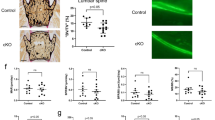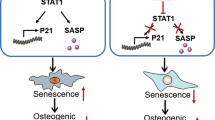Abstract
Senescence marker protein-30 (SMP30) decreases androgen-independently with aging and is a lactone-hydrolyzing enzyme gluconolactonase (GNL) that is involved in vitamin C biosynthesis. In the present study, bone properties of SMP30/GNL knockout (KO) mice with deficiency in vitamin C synthesis were investigated to reveal the effects of SMP30/GNL and exogenous vitamin C supplementation on bone formation. Mineral content (BMC) and mineral density (BMD) of the mandible and femur of SMP30/GNL KO and wild-type mice at 2 and 3 months of age with or without vitamin C supplementation were measured by dual-energy X-ray absorptiometry. Body and bone weight of both age groups decreased and became significantly lower than those of wild-type mice. The bones of SMP30/GNL KO mice were rough and porous, with BMC and BMD significantly below wild-type. Oral supplementation with vitamin C eliminated differences in body weight, bone weight, BMC, and BMD between SMP30/GNL KO and wild-type mice at each age. These results indicate that bone degeneration in SMP30/GNL KO mice was caused by lack of vitamin C, and that this mouse strain is an appropriate model for bone metabolism in humans, which have no ability to synthesize vitamin C.





Similar content being viewed by others
References
Boskey AL, Coleman R. Aging and bone. J Dent Res 2010;89:1333–1348. doi: 10.1177/0022034510377791.
Seeman E. Age-and menopause-related bone loss compromise cortical and trabecular microstructure. J Gerontol A Biol Sci Med Sci 2013;68:1218–1225. doi: 10.1093/gerona/glt071.
Langsetmo L, Barr SI, Berger C, Kreiger N, Rahme E, Adachi JD, Papaioannou A, Kaiser SM, Prior JC, Hanley DA, Kovacs CS, Josse RG, Goltzman D; CaMos Research Group. Associations of protein intake and protein source with bone mineral density and fracture risk: A population-based cohort study. J Nutr Health Aging 2015;19:861–8. doi: 10.1007/s12603-015-0544-6.
Sotunde OF, Kruger HS, Wright HH, Havemann-Nel L, Kruger IM, Wentzel-Viljoen E, Kruger A, Tieland M. Lean mass appears to be more strongly associated with bone health than fat mass in urban black south African women. J Nutr Health Aging 2015;19:628–36. doi: 10.1007/s12603-015-0492-1.
Franceschi RT. The role of ascorbic acid in mesenchymal differentiation. Nutr Rev 1992;50:65–70.
Roughead ZK, Kunkel ME. Effect of diet on bone matrix constituents. J Am Coll Nutr 1991;10:242–246.
Kaptoge S, Welch A, McTaggart A, Mulligan A, Dalzell N, Day NE, Bingham S, Khaw KT, Reeve J. Effects of dietary nutrients and food groups on bone loss from the proximal femur in men and women in the 7th and 8th decades of age. Osteoporos Int 2003;14:418–428.
Sahni S, Hannan MT, Gagnon D, Blumberg J, Cupples LA, Kiel DP, Tucker KL. Protective effect of total and supplemental vitamin C intake on the risk of hip fracture—a 17-year follow-up from the Framingham Osteoporosis Study. Osteoporos Int 2009;20:1853–1861. doi: 10.1007/s00198-009-0897-y.
Talaulikar VS, Chambers T, Manyonda I. Exploiting the antioxidant potential of a common vitamin: could vitamin C prevent postmenopausal osteoporosis? J Obstet Gynaecol Res 2012;38:253–257. doi: 10.1111/j.1447-0756.2011.01629.x.
Maruyama N, Ishigami A, Kondo Y. Pathophysiological significance of senescence marker protein-30. Geriatr Gerontol Int 2010;10 Suppl 1:S88–98. doi: 10.1111/j.1447-0594.2010.00586.x.
Kondo Y, Inai Y, Sato Y, Handa S, Kubo S, Shimokado K, Goto S, Nishikimi M, Maruyama N, Ishigami A. Senescence marker protein 30 functions as gluconolactonase in L-ascorbic acid biosynthesis, and its knockout mice are prone to scurvy. Proc Natl Acad Sci U S A 2006;103:5723–5728.
Ishigami A, Fujita T, Handa S, Shirasawa T, Koseki H, Kitamura T, Enomoto N, Sato N, Shimosawa T, Maruyama N. Senescence marker protein-30 knockout mouse liver is highly susceptible to tumor necrosis factor-α-and Fas-mediated apoptosis. Am J Pathol 2002;161:1273–1281.
Kondo Y, Sasaki T, Sato Y, Amano A, Aizawa S, Iwama M, Handa S, Shimada N, Fukuda M, Akita M, Lee J, Jeong KS, Maruyama N, Ishigami A. Vitamin C depletion increases superoxide generation in brains of SMP30/GNL knockout mice. Biochem Biophys Res Commun 2008;377:291–296. doi: 10.1016/j.bbrc.2008.09.132.
Sato Y, Kajiyama S, Amano A, Kondo Y, Sasaki T, Handa S, Takahashi R, Fukui M, Hasegawa G, Nakamura N, Fujinawa H, Mori T, Ohta M, Obayashi H, Maruyama N, Ishigami A (2008) Hydrogen-rich pure water prevents superoxide formation in brain slices of vitamin C-depleted SMP30/GNL knockout mice. Biochem Biophys Res Commun 2008;375:346–350. doi: 10.1016/j.bbrc.2008.08.020.
Amano A, Aigaki T, Maruyama N, Ishigami A. Ascorbic acid depletion enhances expression of the sodium-dependent vitamin C transporters, SVCT1 and SVCT2, and uptake of ascorbic acid in livers of SMP30/GNL knockout mice. Arch Biochem Biophys 2010;496:38–44. doi: 10.1016/j.abb.2010.01.012.
Ishikawa Y, Hashizume K, Kishimoto S, Tezuka Y, Nishigori H, Yamamoto N, Kondo Y, Maruyama N, Ishigami A, Kurosaka D. Effect of vitamin C depletion on UVR-B induced cataract in SMP30/GNL knockout mice. Exp Eye Res 2012;94:85–89. doi: 10.1016/j.exer.2011.11.010.
Arai KY, Sato Y, Kondo Y, Kudo C, Tsuchiya H, Nomura Y, Ishigami A, Nishiyama T. Effects of vitamin C deficiency on the skin of the senescence marker protein-30 (SMP30) knockout mouse. Biochem Biophys Res Commun 2009;385:478–483. doi: 10.1016/j.bbrc.2009.05.104.
Koike K, Kondo Y, Sekiya M, Sato Y, Tobino K, Iwakami SI, Goto S, Takahashi K, Maruyama N, Seyama K, Ishigami A. Complete lack of vitamin C intake generates pulmonary emphysema in senescence marker protein-30 knockout mice. Am J Physiol Lung Cell Mol Physiol 2010;298:L784–792. doi: 10.1152/ajplung.00256.2009.
Sato Y, Arai KY, Nishiyama T, Nomura Y, Kishimoto Y, Aizawa S, Maruyama N, Ishigami A. Ascorbic acid deficiency leads to epidermal atrophy and UVB-induced skin pigmentation in SMP30/GNL knockout hairless mice. J Invest Dermatol 2012;132:2112–2115. doi: 10.1038/jid.2012.105.
Furusawa H, Sato Y, Tanaka Y, Inai Y, Amano A, Iwama M, Kondo Y, Handa S, Murata A, Nishikimi M, Goto S, Maruyama N, Takahashi R, Ishigami A (2008) Vitamin C is not essential for carnitine biosynthesis in vivo: verification in vitamin C-depleted senescence marker protein-30/gluconolactonase knockout mice. Biol Pharm Bull 2008;31:1673–1679.
Iwama M, Shimokado K, Maruyama N, Ishigami A. Time course of vitamin C distribution and absorption after oral administration in SMP30/GNL knockout mice. Nutrition 2011;27:471–478. doi: 10.1016/j.nut.2010.04.010
Tanaka S, Kuwahara S, Nishijima K, Ohno T, Nagaya M, Nakamura Y, Sumi Y, Miyaishi O, Aoyama H, Goto N. Comparison of rat mandible bone characteristics in F344 substrains, F344/Du and F344/N. Exp Anim 2006 55:415–8.
Institute of Medicine. Food and Nutrition Board. Dietary Reference Intakes for Vitamin C, Vitamin E, Selenium, and Carotenoids. National Academy Press, Washington, DC, 2000.
Naidu KA. Vitamin C in human health and disease is still a mystery? Nutr J 2003;2:7.
Nankivell BJ, Murali KM. Images in clinical medicine. Renal failure from vitamin C after transplantation. N Engl J Med 2008;358:e4. doi: 10.1056/NEJMicm070984.
Domingo JL, Gomez M, Llobet JM, Jacinto Corbella J. Influence of some dietary constituents on aluminum absorption and retention in rats. Kidney International 1991;39, Issue 4, April 1991, Pages 598–601
Cannata-Andía JB, Fernández-Martín JL. The clinical impact of aluminium overload in renal failure. Nephrol Dial Transplant. 2002;17 Suppl 2:9–12.
Cannata-Andía JB, Rodriguez García M, Gómez Alonso C. Osteoporosis and adynamic bone in chronic kidney disease. J Nephrol. 2013 Jan-Feb;26(1):73–80. doi: 10.5301/jn.5000212.
Author information
Authors and Affiliations
Corresponding author
Rights and permissions
About this article
Cite this article
Nishijima, K., Ohno, T., Amano, A. et al. Bone degeneration and its recovery in SMP30/GNL-knockout mice. J Nutr Health Aging 21, 573–578 (2017). https://doi.org/10.1007/s12603-016-0841-8
Received:
Accepted:
Published:
Issue Date:
DOI: https://doi.org/10.1007/s12603-016-0841-8




